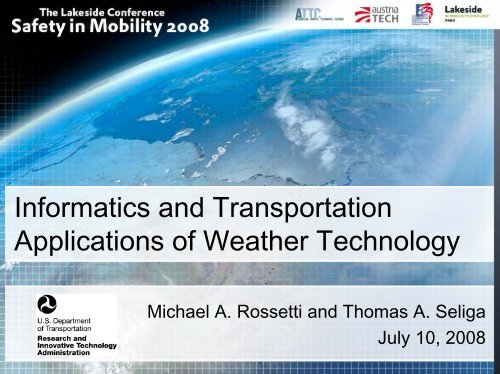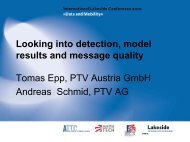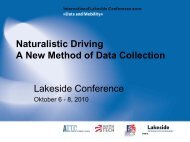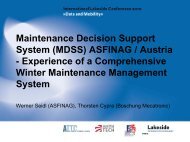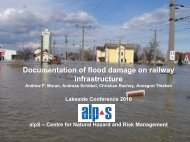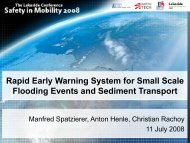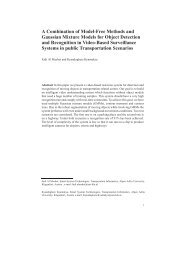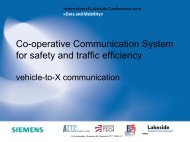Information and transportation applications of weather technologies
Information and transportation applications of weather technologies
Information and transportation applications of weather technologies
Create successful ePaper yourself
Turn your PDF publications into a flip-book with our unique Google optimized e-Paper software.
Informatics <strong>and</strong> TransportationApplications <strong>of</strong> Weather TechnologyMichael A. Rossetti <strong>and</strong> Thomas A. SeligaJuly 10, 2008
Scope/Definitions> Weather Informatics– Includes the combination <strong>of</strong> detection, processing, interpretation,formatting, distribution <strong>and</strong> use <strong>of</strong> <strong>weather</strong> information in realtimefor surface <strong>transportation</strong> operations <strong>and</strong> management– Utilizes: in-situ sensing (surface stations); remote sensing(satellite, radar, lidar, etc); forecasting <strong>and</strong> nowcasting products:data networking; <strong>and</strong> sending, receiving <strong>and</strong> storing informationvia telecommunication devices (telematics), all combined tocomprise practical elements <strong>of</strong> an Intelligent TransportationSystem (ITS)….leading to the concept <strong>of</strong>:> Transportation Weather Informatics (TWI)– Confluence <strong>of</strong> information derived from the elements <strong>of</strong> WeatherInformatics to integrate, format <strong>and</strong> communicate usefulinformation that meets the primary <strong>and</strong> secondary needs <strong>of</strong> thesurface <strong>transportation</strong> community2
Overview/Background> Bridging the gap between <strong>weather</strong> information providers <strong>and</strong> surface<strong>transportation</strong> users> Evolving radar capability <strong>of</strong>fers continuous <strong>and</strong> high-resolutionmonitoring <strong>of</strong> <strong>weather</strong> over surface <strong>transportation</strong> networks> Era <strong>of</strong> major advances in numerical <strong>weather</strong> models> Availability <strong>of</strong> digital forecast databases> Advances in navigation, computer processing <strong>and</strong> telecommunicationsare enabling <strong>technologies</strong>> TWI has great potential for the development <strong>of</strong> indices that canidentify, locate <strong>and</strong> communicate road <strong>weather</strong> conditions <strong>and</strong> hazards> Benefits extend to many users <strong>and</strong> include improved operationalcapabilities available for real-time decision making <strong>and</strong> near- <strong>and</strong> longtermplanning> Two sample case studies: Florida crash in fog/smoke on I-4, Atlantaheavy rain impacts on I-75
Examples <strong>of</strong> Related US Efforts> Clarus> Maintenance Decision Support System (MDSS)> Vehicle Infrastructure Integration (VII)/Safe Trip21> Meteorological Assimilation <strong>and</strong> Data <strong>Information</strong>System (MADIS)> Real-time traffic information (e.g. Smart Traveler)> Wireless mesh networks (developing technology)4
Real Time Traffic <strong>Information</strong>/Smart TravelerA commercial service in the US that provides trafficinformation to more than 100 million commuters daily throughan affiliate network <strong>of</strong> more than 2,500 broadcast <strong>and</strong> digitalmedia customers.- Delivers a simple <strong>and</strong> intuitive user interface, <strong>and</strong> ispowered by Maptuit, a leading provider <strong>of</strong> mapping <strong>and</strong> navigationsolutions.- Real-time traffic is automatically updated every fewminutes through a local network <strong>of</strong> traffic reporting centers,providing users with the most current, timely <strong>and</strong> accurate trafficincident, construction <strong>and</strong> highway speed information available.- Includes access to RealTraffic, interactive full-color,street-level maps displaying traffic conditions for over 100 majormarkets <strong>and</strong> door-to-door directions throughout North America.5
Wireless Mesh Networks> Enables computers to communicate to each otherwithout going through central servers or networks.– MIT <strong>and</strong> other researchers are developing <strong>and</strong> testingprototype "mesh networks"– Would enable cars to act as roving <strong>weather</strong> stations,gathering both meteorological <strong>and</strong> road conditions,<strong>and</strong> sharing data <strong>and</strong> related information withneighboring cars through mesh networks. Samplemessages:• Slippery road ahead, slow down NOW!• Dense fog ahead with stopped vehicles in road, use extremecaution!6
Required Resources for a TWI System> Direct access to:– Surface Weather Station Observations– Weather Radar Data– Satellite– Lightning Detection <strong>and</strong> Reporting System– National <strong>and</strong> Regional Forecast <strong>and</strong> NowcastProducts (e.g., Rapid Update Cycle (RUC) II, NAMMM5, UKMET, ECMWF, etc.)– Real-time traffic information– Roadway attributes – physical <strong>and</strong> environmental– Human factors – localized> Cross-Jurisdictional Cooperation <strong>and</strong> Participation> Financial Commitment7
Weather Radar Focus: NEXRAD, TDWR <strong>and</strong>Private Sector> More than any other system, <strong>weather</strong> radar <strong>of</strong>fers unrealized opportunities for<strong>applications</strong> to highway traffic management <strong>and</strong> the associated user community> Resource is both an established technology <strong>and</strong> continually improving> Opportunities will be further enhanced as deployment <strong>of</strong> dual polarization capabilitiescome on line; e.g., the US NEXRAD system is expected to have this capability within~5 yrs, <strong>and</strong> there is potential for similar upgrades on the Terminal Doppler WeatherRadars (TDWR). Commercial systems are also coming on line in major populationcenters. Many other countries have comparable capabilities or can readily acquirethem.> The concept has already been demonstrated; e.g., by using a NEXRAD radar toproduce rainfall-dependent indices that affect driving - a highway wetness index(HWI) <strong>and</strong> a rainfall visibility impairment index were merged into a combined hazardindex (CHI).> Other indices can also be defined <strong>and</strong> included in CHI. Examples include effects dueto other traffic <strong>and</strong> <strong>weather</strong> attributes such as accidents, traffic volume, windconditions, fog, hail, glare, hazardous <strong>and</strong> non-hazardous spills, etc.> The products can be mapped directly along routes <strong>of</strong> interest <strong>and</strong> tailored for specificusers’ needs. Time domain <strong>of</strong> the products can typically extend over hours <strong>and</strong>include nowcasting out to around 1-2 hrs with temporal resolutions down to around 1-5 minutes.9
Importance <strong>of</strong> Wet Roads
Development <strong>of</strong> Hazard Indices (sample illustrations)> Precipitation– Type– Intensity– Location> Rainfall– Wetness index• Loss <strong>of</strong> traction• Hydroplaning speed/risk– Visibility impairment– Glare enhancement> Winds– Headwinds– Cross winds– Gusts> Other Physical <strong>and</strong> Human Factor Attributes11
Early Demonstration <strong>of</strong> NEXRAD-Derived Rainfall DrivingConditions (Wetness <strong>and</strong> Visibility Impairment)
Traffic Flow Decelerates <strong>and</strong> Accelerates in Response toHazard IndexACCELERATINGTRAFFICDECELERATINGTRAFFIC
Atlanta NEXRAD, June 30, 200314
Transformation <strong>of</strong> Radar Measurements to RainfallRate along Designated Route-6Reflectivity Factor: Z(dBZ) = 10log(Z)60-6Filtered Rainfall Rate: R(dBR) = 10log(R)25-550-52015Time (hrs) RE: Current Time = 0-4-3-2403020Time (hrs) RE: Current Time = 0-4-3-21050-5-110-1-1000 20 40 60 80 100 1200Distance (sm) along I-75 in Georgia from S <strong>of</strong> Forsyth through Atlanta to N <strong>of</strong> Calhoun0 -150 20 40 60 80 100 120Distance (sm) along I-75 in Georgia from S <strong>of</strong> Forsyth through Atlanta to N <strong>of</strong> Calhoun15
150100050-5-1016Roadway Wetness ParameterG- 36G- 20 US-41 I- 85 I- 85 G-120 G- 20G- 23I-675 I-285 I- 20 I-285 I-575 G-1401-5555-105555010100-1055-550-550-55-5-5-5-55-10-1055-5-5-10-5-5-5-510-5-5-10-10-100100-10-5-5-10-10-10-10-10-5-1050-10-50555-50-500-1-2-3-4-5-5-5-100-10-5-10-10-100-10-51505-10-50105-10-10Time (hrs) RE: Current Time = 05-1015-10-50-10100-10-5-50-10-10-10-10-10-105101055-1050-5-60 20 40 60 80 100 120 140Distance (sm) along I-75 in Georgia from S <strong>of</strong> Forsyth through Atlanta to N <strong>of</strong> Calhoun
10090908070Hydroplaning Speed in MPH170G- 20 US-41I- 85 I- 85G-120G- 20I-675I-285 I- 20 I-285I-575G-1409080909080807070707010060801001009080907080801006090807080 9010010010080809090908090100706070907010090708010010090809010090100707010050607080Time (hrs) RE: Current Time = 080808090709080607090907070 600-1-2-3-45070807070609090100608070100100100-59040 50 60 70 80 90 100 110 120 130-660Distance (sm) along I-75 in Georgia from S <strong>of</strong> Forsyth through Atlanta to N <strong>of</strong> Calhoun5040Hydroplaning Speed (mph)17
Example: Crash in Fog <strong>and</strong> Smoke – Polk City, FloridaEvent Record Details> Event: Dense Fog Date:09 Jan 2008, 04:00:00 - 09:00:00 AM ESTFatalities: 5 Injuries: 38 Zones affected:> Description:A controlled burn from the previous afternoon was still producingsmoke as patches <strong>of</strong> dense fog began to develop around 4AM. Thesmoke <strong>and</strong> fog interacted to produce super-fog along a 2 mile areaencompassing Interstate 4 near Polk City between US 27 <strong>and</strong> thePolk Parkway. The super-fog caused zero visibility for motorists <strong>and</strong>the result was a 70 vehicle pileup with 5 fatalities <strong>and</strong> 38injuries.High pressure in place across the area allowed for moist lowlevels <strong>and</strong> light winds overnight.18
Aftermath <strong>of</strong> Eventhttp://media.tbo.com/photos/trib/2008/feb/20508i-4file.jpg19
Fog <strong>and</strong> Smoke Area, I-4, Polk City FL20
RUC Products – Visibility
RUC Products – Temperature; Winds; Humidity
Needs/Decisions> Effective human-machine interface> Best ways to deliver <strong>weather</strong> content to drivers> Telematics/navigation devices capable <strong>of</strong>combining & displaying vehicle position <strong>and</strong>driver/traffic-relevant <strong>weather</strong> information> Central source <strong>of</strong> traffic data, camera imagery &other attributes - responsible agents> Institutional cooperation & coordination> Resolution <strong>of</strong> Jurisdictional issues> Roles <strong>of</strong> public <strong>and</strong> private sectors23
Sample Users> National Weather Service WFO> Dept <strong>of</strong> Forestry> Fish <strong>and</strong> Wildlife Conservation Commission> Dept <strong>of</strong> Transportation> OEM> Drivers> Dispatchers> Police <strong>and</strong> Fire> Local media24
Societal Benefits <strong>of</strong> Transportation Weather Informatics> Safety> Efficiency> Return on investment> Helps other sectors <strong>of</strong> the economy> Real-time decision making> Short-term <strong>and</strong> long-term planning25
Summary> Necessary pieces are essentially there– Confluence <strong>of</strong> radar, surface stations, satellite, hi-resmodels, navigation devices, wireless networks, smartvehicles, traffic information telematics =“Transportation Weather Informatics”– High resolution (time <strong>and</strong> space) measurements <strong>and</strong>forecasting <strong>of</strong> <strong>weather</strong> are very good, operationallyavailable <strong>and</strong> getting better– Caveats exist such as occurrences <strong>of</strong> False Alarms> Benefits – safety, efficiency, public trust> Need private sector to set up <strong>and</strong> maintain the network26
ReferencesBenjamin, S. et al. 2007. “The RTMA Background – Hourly Downscaling <strong>of</strong>RUC Data to 5-KM Detail.” Presented at the Annual Meetings <strong>of</strong> theAmerican Meteorological Society. Session P1.11, San Antonio, TX.JanuaryBlack, G.W. 2000. “Pavement Surface Water Phenomena <strong>and</strong> TrafficSafety.” Institute <strong>of</strong> Traffic Engineers, ITE Journal.http://findarticles.com/p/articles/mi_qa3734/is_200002/ai_n8889175Huebner, R. S. 1997. “PAVDRN Computer Model for Predicting Water FilmThickness <strong>and</strong> Potential for hydroplaning on New <strong>and</strong> ReconditionedPavements,” Transportation Research Record 1599, Paper No. 970889,128-131.Mischler, G. 2003. “Lighting Design Knowledgebase,” Lighting Glossary,Glare. http://www.schorsch.com/kbase/glossary/glare.htmlNational Transportation Safety Board (NTSB). 1980. “NationalTransportation Safety Board Special Study: Fatal Highway Accidents onWet Pavement,” Rept. NTSB-HSS-80-1, NTSB Bureau <strong>of</strong> Technology,Washington, DC.Perel, Michael, et al. 2005. “Motor Vehicle Forward Lighting.” SAETechnical Paper Series. Working Paper GTR-gtr-8-6, June.http://www.unece.org/trans/doc/2005/wp29gre/gtr8-6e.pdfPetty, K. <strong>and</strong> W Mahoney. 2007. “Weather Applications <strong>and</strong> ProductsEnabled Through Vehicle Infrastructure Integration (VII): Feasibility <strong>and</strong>Concept Development Study.” Prepared for U.S. Department <strong>of</strong>Transportation, Intelligent Transportation Systems Joint Program Office.http://ops.fhwa.dot.gov/publications/viirpt/viirpt.pdfPisano, P. et al. 2008. “A New Paradigm for Observing the Near Surface<strong>and</strong> Pavement: Clarus <strong>and</strong> Vehicle Infrastructure Integration.”Transportation Research Circular Number E-C126. June.Rossetti, M. <strong>and</strong> M.Johnsen. 2008. “Impacts <strong>of</strong> Weather <strong>and</strong> Climate onCommercial Motor Vehicles”. Presented at the Annual Meetings <strong>of</strong> theAmerican Meteorological Society. Session 4B.4, New Orleans, LA.January 24Rossetti, M.A. 2002. “Implementing Successful Public-Private PartnershipsIn Transportation, Studies Involving Weather And Its Effect OnTransportation.” U.S. Department <strong>of</strong> Transportation, Volpe Center.February.Rubino, M, A. et al. 1994. “Discomfort Glare Indices: A Comparative Study,”Applied Optics, 33, 8001-8013.Seliga, .T.A. 1997. “The NEXRAD Radar System: A New Tool for HighwayTraffic Management.” Seattle, WA: University <strong>of</strong> Washington. March.http://www.transnow.org/publication/final-reports/documents/TNW97-06.pdfSeliga, T. A. <strong>and</strong> K. D. Nguyen. 1996. “The NEXRAD Radar System: A NewTool for Highway Traffic Management <strong>and</strong> Research,” Sixth AnnualMeeting <strong>and</strong> Exposition, Intelligent Transportation Society <strong>of</strong> America,April 15-18, Houston, Texas.Seliga, T. A. <strong>and</strong> L. L. Wilson. 1995. “Applications <strong>of</strong> the NEXRAD RadarSystem for Highway Traffic Management,” Preprints, 27th Conference onRadar Meteorology, Vail, CO, AMS, Boston, MA, Oct. 9-13, 176-178.Stern, A., et al. 2003. “Analysis <strong>of</strong> Weather Impacts on Traffic Flow inMetropolitan Washington DC.” Presented at Annual Meetings <strong>of</strong> theAmerican Meteorological Society, Session 10.3 January.http://ams.confex.com/ams/annual2003/techprogram/paper_54865.htmState <strong>of</strong> New Jersey Department <strong>of</strong> Transportation. 2007. “Roadway DesignManual.”http://www.state.nj.us/<strong>transportation</strong>/eng/documents/RDME/sect5E2001.shtm
References (cont.)U.S. Department <strong>of</strong> Commerce (DOC), National Oceanic <strong>and</strong>Atmospheric Administration (NOAA), Office <strong>of</strong> the FederalCoordinator for Meteorology (OFCM). 2002. “Weather <strong>Information</strong>for Surface Transportation. National Needs Assessment Report.”http://www.<strong>of</strong>cm.gov/wist_report/pdf/20-appe.pdfU.S. Department <strong>of</strong> Transportation (DOT), Federal HighwayAdministration (FHWA). 1994. “Roadway Delineation Practices.”August. http://safety.fhwa.dot.gov/PED_BIKE/docs/rdwydelin.pdfU.S. Department <strong>of</strong> Transportation (DOT), Federal HighwayAdministration (FHWA). 2005. “Road Weather <strong>Information</strong> SystemEnvironmental Sensor Station Siting Guidelines.” April.http://www.ops.fhwa.dot.gov/publications/ess05/ess05.pdf
Thank you for your attention.seliga@volpe.dot.govrossetti@volpe.dot.gov


